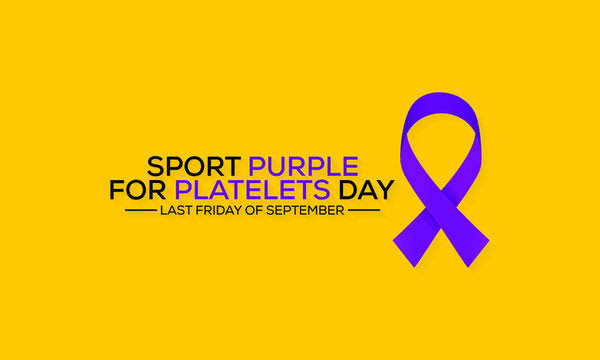Sport Purple for Platelets Day – September 30, 2022, history significance why we celebrate
Get involved in a great cause by celebrating Sport Purple for Platelets Day on September 30. This event, celebrated on the last Friday in September, supports those suffering from Idiopathic Thrombocytopenic Purpura (ITP), a disease that causes excessive bleeding, bruising and fatigue due to low levels of platelets (cells that enable blood to clot). Unfortunately, there are many unknowns about ITP — what causes it, how to fully cure it — and many people haven’t even heard of it.
The Platelet Disorder Support Association (PDSA) sponsors this Sport Purple for Platelets Day. Money raised for ITP sufferers helps educate people on how to detect and live with it. So this year, get in on the action of Sport Purple for Platelets Day: sport purple, raise money and show your support.

SPORT PURPLE FOR PLATELETS DAY TIMELINE
1735
Purpura was throughly understood
Paul Gottlieb Werlhof, a German physician and poet, wrote the most thorough explanation of the purpura of ITP.
1880s
Purpura is connected to platelets
Investigators began to link purpura, a rash of purple spots made of small blood vessels that leak blood into various parts of the body, with platelet count abnormalities.
1916
A splenectomy led to an ITP discovery
Paul Kaznelson, a Polish medical student, contributed to the first successful therapy for ITP.
1950s
Steroids changed the game
They replaced splenectomies as the best remedy option.
2008
Long-term treatment is approved
The FDA approved Romiplostim — an injection that treats adult chronic ITP.
HOW TO OBSERVE SPORT PURPLE FOR PLATELETS DAY
Host a fundraiser
Raising money is a great way to help the Platelet Disorder Support Association (PDSA) achieve its goals. Golf outings, bowl-a-thons, or walks are great fundraiser ideas that help bring the ITP community together, while also raising money and awareness.
Light up the night
Hanging purple lights is a luminous way to celebrate. First, reach out to friends and family, local office buildings and restaurants; then, contact those in charge of lighting bridges and skyscrapers in the city closest to you.
It may seem obvious, but…sport purple!
Wear purple, use purple pens at work and send your kids to school with purple accessories. If enough people in your community wear purple on September 27, then those who don’t know the significance of the day may inquire about it — creating a new opportunity to inform, educate and raise awareness.
RECOMMEND STORIES
- Remembering Ratan Tata: A Visionary Leader and Compassionate Humanitarian
- National College Colors Day – September 2, 2024: history
- Bison-ten Yell Day – September 2, 2024: history, FAQs
- National Lazy Mom’s Day – September 6, 2024
- World Coconut Day – September 2, 2024: A Nutty Celebration!
5 ITP FACTS TO CONSIDER WHILE YOU ROCK THE PURPLE
It was one of the first autoimmune disorders discovered
ITP was one of the first diseases that proved the body’s own tissue could be attacked by its antibodies.
It’s more common in women
Women are twice as likely to get ITP than men.
ITP can lower your life expectancy
In fact, your life expectancy can be shortened by up to 20 years!
Viral infections can cause it
All viral infections can potentially lead to acute ITP.
ITP can be the result of vaccines
Some popular vaccines (MMR, HPV) have been linked to ITP.
WHY SPORT PURPLE FOR PLATELETS DAY IS IMPORTANT
It spotlights a rare disease
Even though ITP affects more people than hemophilia — approximately 10 times more people — ITP isn’t as well known. Sport Purple for Platelets Day offers a chance to educate the public on what it is and how to support those who have it.
It supports those who suffer from ITP
Not only does Sport Purple for Platelets Day raise money for programs and research funds, but the ITP community also benefits, socially. Fundraising events connect ITP sufferers with one another — and the environment can be therapeutic in a way that helps alleviate their anxiety.
It raises money for a worthy cause
Since its inception, Sport Purple for Platelets Day fundraising events have raised about $700,000. This money has been essential in helping fund the many free services and programs provided to ITP sufferers and their families, as well as funding for research.








